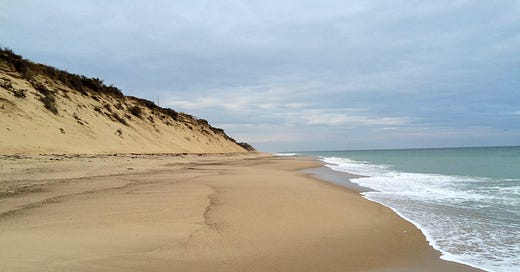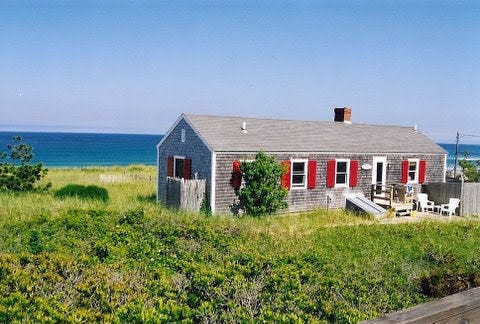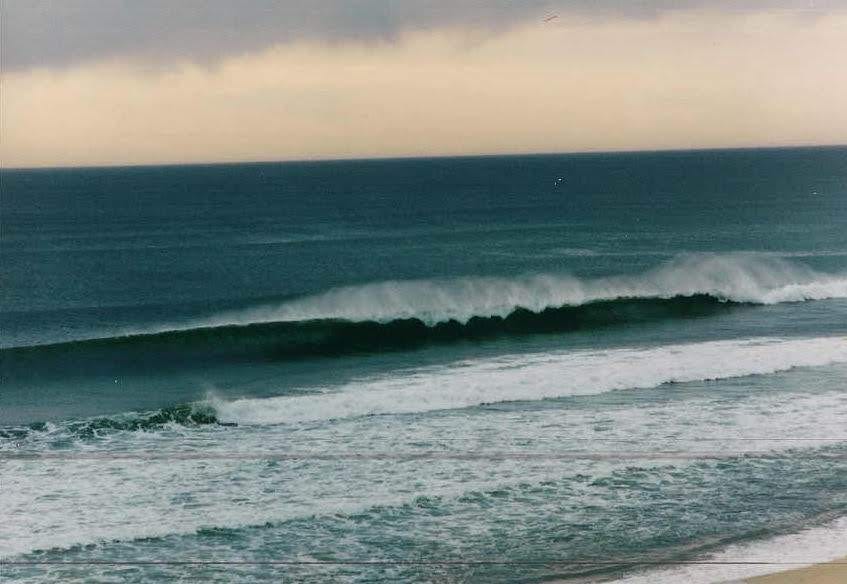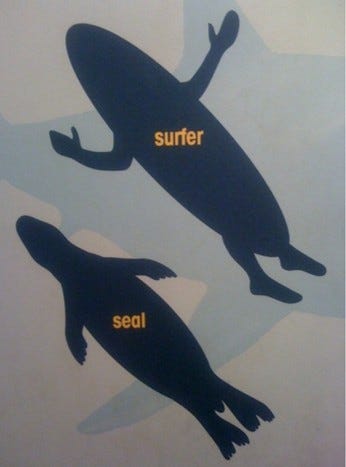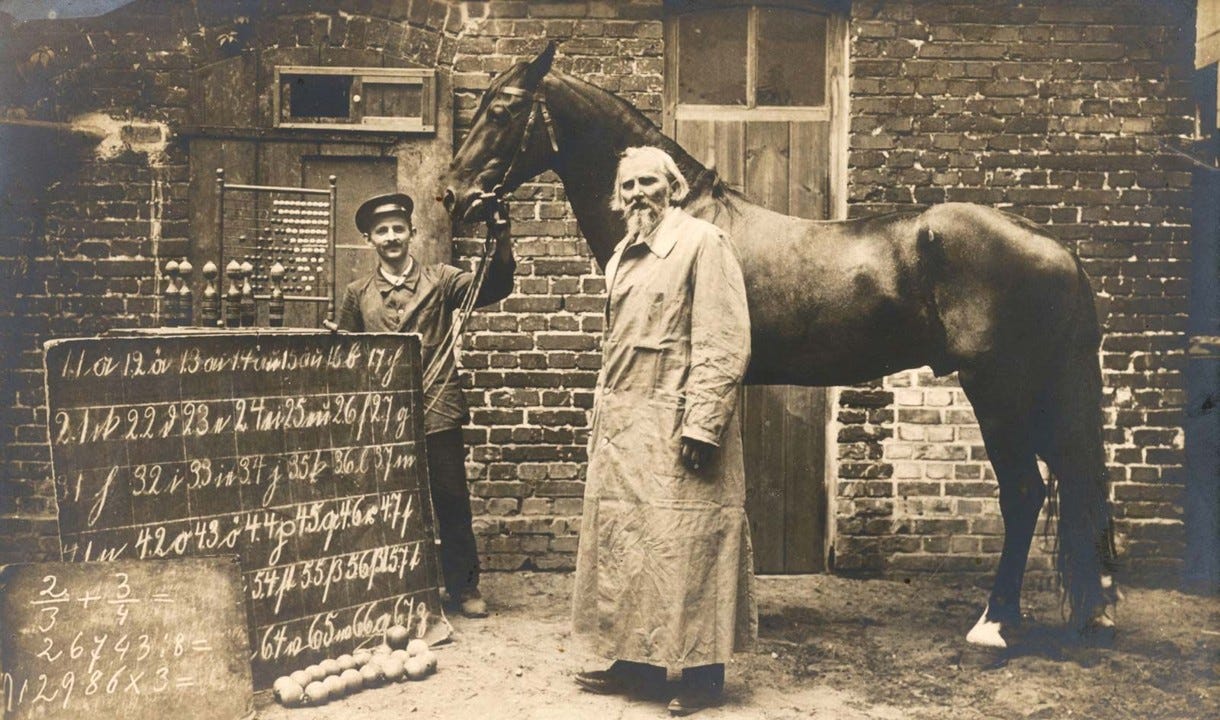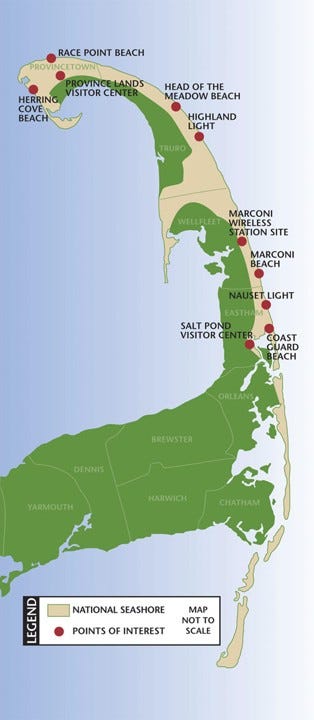Meandering Tour
Carcharodon carcharias | AAA | My Mother | Clever Hans and Paul the Octopus | Tok Pisin Redux
5) I went to the windswept shore because I wished to surf deliberately
This week, I’m visiting the outer reaches of Cape Cod. “A man may stand there and put all America behind him," Thoreau wrote in the mid-19th century of his walking tours1 of the “the bared and bended arm of Massachusetts.”
“The time must come,” he nevertheless predicted, “when this coast will be a place of resort for those New Englanders who really wish to visit the seaside.” And so it is, but the ocean-facing tip of the Cape, which includes a 40-mile stretch of protected national seashore, remains surprisingly unspoiled — full of wide, empty beaches, towering sand dunes, wild flowers, and pounding waves.2
I’ve had the good fortune of coming here with my family every summer for the last 40 years. We resided most of that time in a small cottage with red shutters in the town of Wellfleet, perched atop a 100-foot dune overlooking the Atlantic Ocean, a spot which boasts one of the best surf breaks in New England.
Thoreau, of course, could not have foreseen that particular feature, but his description of the waves on the Cape perfectly matches the view I often had from the cottage: “The breakers looked like droves of a thousand wild horses of Neptune, rushing to the shore, with their white manes streaming far behind; and when, at length, the sun shone for a moment, their manes were rainbow-tinted.”
Thoreau also wrote extensively about the marine wildlife, including the seals he was surprised to encounter: “The Boston papers had never told me that there were seals in the harbor. I had always associated these with the Esquimaux and other outlandish people. Yet from the parlor windows all along the coast you may see families of them sporting on the flats.”
A century later, the seals on Cape Cod were on the verge of extinction due in part to a bounty program supported by the fishing industry. In 1972, Congress passed the Marine Mammal Protection Act. As a result, there are now an estimated 50,000 grey and harbor seals in the waters off the Cape. Great White Sharks (Carcharodon carcharias) now travel3 here in the summer to feast on them.
And when I say “here,” I mean in front of where the cottage used to stand. It was demolished in 2022 due to the erosion of the dune, but the sharks naturally are still hunting.
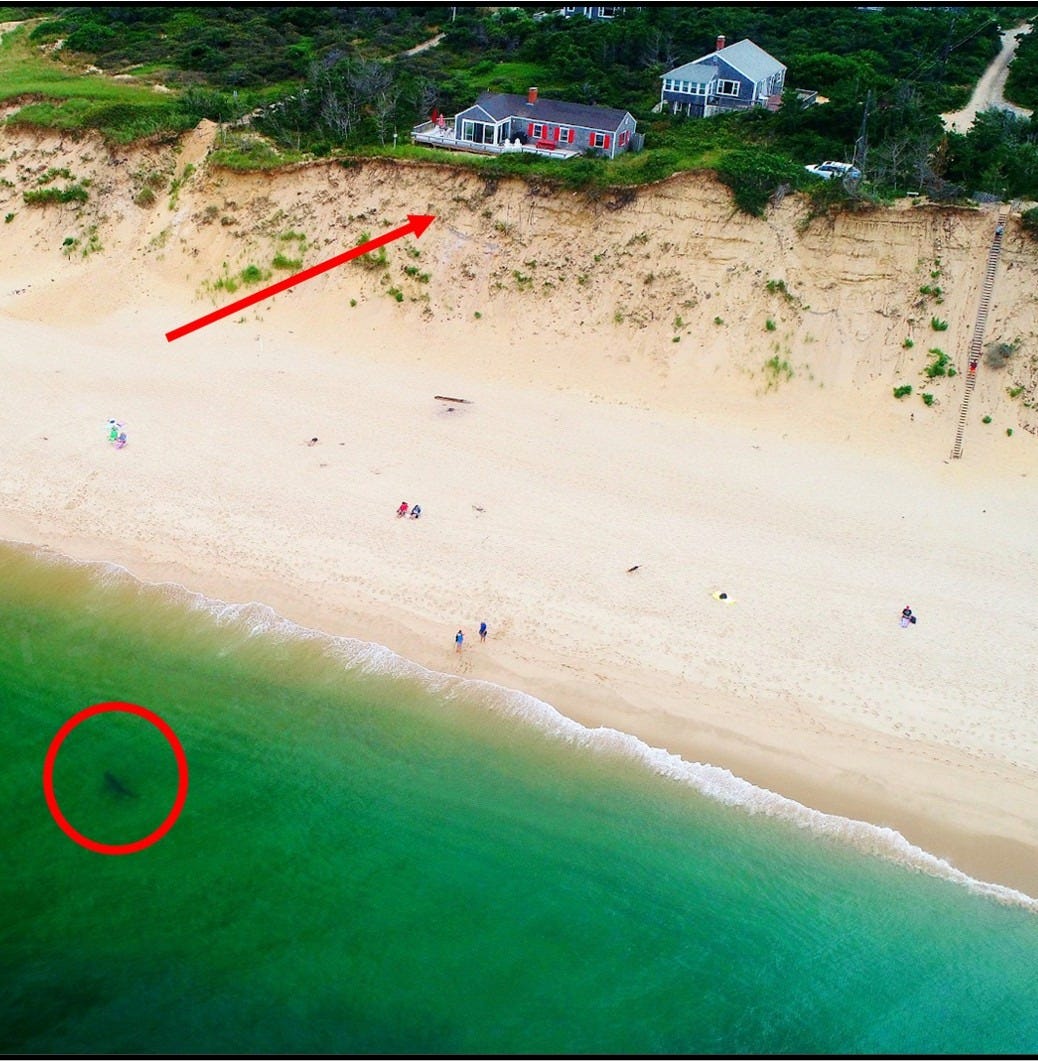
Sharks apparently don’t see very well. Researchers theorize they often mistake surfers and boogie boarders, particularly those wearing black wetsuits, for seals due to their similar silhouettes.” Sharks bite first, realize a human isn’t a seal, and move on, but by then the damage is done.
When the swell is right, the surfing here can be spectacular, as seen in this video taken from the cottage.
But look who’s bobbing nearby, thanks to the Marine Mammal Protection Act:
In August 2018, a swimmer survived a bite by a Great White about 8 miles north of our location. The following month, a 26-year-old boogie boarder was killed by a shark three miles north, the first such fatality in Massachusetts in more than 80 years.
Warning signs went up at the four guarded beaches in Wellfleet along with “Stop the Bleed” first-aid stations. WiFi receivers were installed to facilitate 911 calls from the beach and a quick response in case of emergency. Shark safety tips exploded in print and online, such as this list from the Cape Cod Chamber of Commerce:
Do not swim near seals.
Do not swim alone in the ocean at dawn or dusk.
Limit splashing and do not wear shiny jewelry.
Avoid murky or low-visibility water, which makes it difficult to see sharks and for sharks to see you.
Wearing a wet suit may give the appearance of a seal, unless it is highly and colorfully patterned.
And this amusing, but understandable, one, listed under "other beach and swimming safety tips": Never turn your back to the ocean.
The press eagerly covered the story, with National Geographic publishing a feature two months after the tragedy under this sensational headline:
After a fatal shark attack, how does a town adapt?
Cape Cod knew it could happen any day, but reality has set in. Now the community must grapple with what it means to be a Great White Shark epicenter.
Even three years later, The New York Times Magazine weighed in with a cover story titled “Fear in the Shallows.” The bright red headline inside read, “Fear on Cape Cod as Sharks Hunt Again,” accompanied by an overhead photo of a swimmer and a shark “coexisting” just offshore.

Despite these alarming reports, there haven’t been any shark-related injuries since 2018, although in November 2023, a Great White “attacked” a Stand Up Paddle (SUP) board; the paddler wasn’t hurt. Tech solutions, including drones and buoys that detect tagged sharks, are being tested. In the meantime, tourism doesn’t seem to have suffered at all. In fact, shark tourism on charter boats has taken off.
As for my personal experience, when family and friends jump in the ocean these days to cool off, they tend not to linger as long as we used to, although there are many swimmers who still do. And when the swell picks up, there are as many surfers as ever, including me.
In Thoreau’s time, the inhabitants of the Cape apparently were more cautious:
Serpents, bears, hyenas, tigers, rapidly vanish as civilization advances, but the most populous and civilized city cannot scare a shark far from its wharves. . . . The ocean there is commonly but a tantalizing prospect in hot weather, for with all that water before you, there is, as we were afterward told, no bathing on the Atlantic side, on account of the undertow and the rumor of sharks.
As you know by now, I’m a terrible worrier, but mostly about small stuff, so my risk-reward analysis goes something like this: good summer waves are rare, the thrill of surfing is unmatched, and . . . what are the chances? My sister-in-law captured my sentiment in this drawing she gave me as a Christmas present several years ago.

For the record, today — June 20, 2025 — happens to be the 50th anniversary of the release of the movie Jaws.
4) Drive to the Slauson Cutoff, Get Out of Your Car . . . .
I was driving around Santa Fe, New Mexico in mid-April, when I noticed an office building with the logo of the Automobile Association of America — an actual brick-and-mortar structure. Why?
As one of 60 million members in North America, I use AAA from time to time for its roadside assistance. What else is there? Quite a bit, it turns out, including one item readers of a certain age might assume has gone the way of the pneumatic mail tube: the TripTik Travel Planner.
For those of you who never rode unbelted in the back of a Ford Country Squire station wagon, the original TripTik was a spiral bound booklet containing driving directions in the form of excerpted sections of roadmaps, with the route highlighted by hand. It eliminated the need for mom to wrestle with a four-foot, accordion-like expanse of map in the front passenger seat to find the exit to Fort Lee, NJ, while the kids were screaming in the wayback. (Times have changed; my wife Julie rarely lets me get behind the wheel.)
You’d walk into your local AAA office, tell the manager you were planning to drive from, say, Baltimore to New Haven, and the staff would assemble a TripTik on the spot. The first page would get you from Charm City to the City of Brotherly Love. Flip the page to navigate to the Capital City (“Trenton Makes, the World Takes”). Keep leafing through, and the orange highlighter would guide you around Gotham, then steer you north, eventually depositing you in the Elm City.
Fast forward, and we have Google Maps, Apple Maps, MapQuest, and Waze at our fingertips
So how can it be possible that a projected 1.2 million TripTiks will be printed at approximately 800 U.S. branch offices and at home in 2025, according to Ellen Edmonds, the association’s director of external communications, in response to my email query?
Finding that claim difficult to fathom in these modern times, I went online last week to order a TripTik for a hypothetical trip from Baltimore to Peoria (the “Whiskey Capital of the World”).
I received an email confirmation, saying my order would arrive by U.S. mail within seven business days. It came in five. For me, it was a veritable cartographic madeleine, complete with turn-by-turn directions, an expense log, a miles per gallon calculation table, a list of state-by-state driving regulations, a page for trip notes, and so-called “maneuver maps” to navigate tricky turns in the metropolis that is Peoria.
Coming soon on Meandering Tour: best deals on home delivery of the Encyclopedia Britannica.
3) Mother Lode
How has technology affected the cognition of the first generation to have used computers, smartphones, and the Internet as they approach an age where the risks of dementia start to emerge?
The “digital dementia hypothesis” suggests that extended technology exposure worsens cognitive abilities. (The popular term is “brain rot.”) But in a meta-analysis published in the April edition of the journal Nature Human Behavior, neuroscientists at Baylor University and the University of Texas at Austin found the opposite: the use of digital technologies is associated with a reduced risk of cognitive impairment. To support this conclusion, they reviewed 136 studies of more than 400,000 adults.4
"We could spend a long time talking about all the specific ways in which technology use can be bad,” Michael Scullin, one of the investigators, told Medical Xpress. “However, the net effect since the 1990s has been positive for overall cognition in older adults.”5
Could this finding at least partially explain the vitality of my 95-year-old mother, Gilda? She wears an Apple Watch and owns an iPhone, iPad, and desktop computer, often using several of these devices at once. She FaceTimes and Zooms with her children, grandchildren, and great-grandchildren. She reads voraciously on her Kindle and streams foreign films and classic American movies. She’s a mother lode of digital dexterity.
There are no doubt other explanations for my mother’s mental acuity. She has many younger friends, still drives during the day, and leads a very active social life. Oh, and she’s an avid sports fan, with a fierce loyalty to the Crimson Tide. Still, there must be something about her deep engagement with technology that contributes to the wonderful texture of her life, and I am fortunate to be part of it.
Gilda turns 96 next week. Happy birthday, Mom. I love you, but could you please learn how to change the damn printer cartridges yourself!
2) Sidetracks
Masterclass: One of my favorite Instagram accounts is Art But Make It Sports, where curator LJ Rader pairs photos of viral sporting events with uncannily similar fine art. Rader, a connoisseur of both fields, says he does not use artificial intelligence. “I do it for the enjoyment of it,” he told the New York Times last year. “It keeps me sharp and gets me out of the house and gets me going to different galleries and shows and museums.” Here are some examples of Rader’s miraculous recall and pairings.

From left to right: Jason Kelce and “The Feast of Bacchus” by Philips Koninck; college students tearing down a goal post and “Christ Carrying the Cross” by Hieronymus Bosch; Golden State Warriors stars Draymond Green, Klay Thompson, and Stephen Curry and Bisa Butler’s “Three Kings” (Source: New York Times) Phenomenon of the Week: With a tip of the hat to my online friends in Connecticut, I was reminded this week of the Clever Hans Effect. Hans was a horse who, in Germany in the 1890s, supposedly performed mathematical calculations and other feats of intelligence, by tapping a hoof in relation to a code written on a blackboard. In 1907, psychologist Oskar Pfungst demonstrated that the horse was “not actually performing these mental tasks but was watching the reactions of his trainer. The horse was responding directly to involuntary cues in the body language of the human trainer, who was entirely unaware that he was providing such cues.” The Clever Hans Effect has remained an important principle to consider when conducting cognitive tests of animals. I haven’t had time to research if this phenomenon had any bearing on the extraordinary record of Paul the Octopus in accurately predicting the results of international soccer matches.6
1) Reader Mail
Tok Pisin: Elwin from Connecticut wrote this wonderful note in response to last week’s summary of an Economist feature about the world’s most pleasant-sounding language, according to a recent academic study: Tok Pisin, an English creole spoken in Papua New Guinea [click here to listen to a sample]:
Life is full of surprises. Your missive coincided with last week’s 30-year reunion of Peace Corps Volunteers that served under my Country Director’s watch in the Solomon Islands, Melanesia, South Pacific (1993-95). For those years, and at last week’s affair, my wife Joan and I heard Tok Pisin spoken as much as English. Tok Pisin is a “trade language” developed by the indigenous tribes of Melanesia after a century of encounters with sailors from every exploring country on earth. Hence, the language is an amalgam of the sounds of words from all over. Interestingly, there are hundreds of “local” tribal languages, and islands, in the Solomons. An island might have a half dozen tribes, each with its own language, but the only communication between them was Tok Pisin. It is not only pleasant sounding, its fun. So that said, I crown Tok Pisin the world’s prettiest language, “with authority.”
Surely, You Jest: Last week, I asked, “Has anyone you know ever finished reading David Foster Wallace’s 1,100-page novel Infinite Jest?”
First Place (25 wallet cards) goes to Bryan from Maryland who wrote: “I read (and finished) Infinite Jest during a six or seventh month stint when I was selling mattresses. Truly, being able to lounge on a bed all day getting paid to read a doorstop is the best way to experience such a hefty, complex tome.”
Second Place (50 wallet cards) goes to Mark, also from Maryland: “2/3 done, going on 15 years.”
What’s in a Name?: As you might imagine, my post on nominative determinism elicited the most mail.
Jessica (California): “I used to go to a dentist named Dr. Hirt [Editor’s Note: spelled with an “i,” but still counts]. I'd cringe with every appointment reminder. Finally, I booted him in favor of Dr. Mendelowitz.”
Colin (Connecticut): “I once had a dentist named Dr. Fillmore”: Stories of nominative determinism
Ben (Maryland): “Your column makes me wonder why one of my classmates in medical school, Brenda Nurse, chose her profession.” Trust, but verify. I checked online, and it’s true.
Jeff (Maryland): “Alonzo Ball (professional basketball player), Dr. Brain (a friend’s shrink), the Tennis brothers (John, Billy, and Luke), all avid players”
Another brainiac, Nancy (also from Maryland): “Lord Walter Russell Brain (British neurologist) and Graham Crackers (renowned lunatic) — OK, I made that one up.”
Natalie (Washington, DC): “It's only tangentially related to the literature on aptonyms or onomastics (two terms that are new to me), but I can't resist mentioning a book called Remarkable Names of Real People, by John Train. It includes some aptonyms — notably, gynecologist Dr. Zoltan Ovary and (perhaps) Cardinal Sin, Archbishop of Manila. But there are also a bunch of names that are intriguing for non-aptonymic reasons, like Osborn Outhouse of Boston, MA, and Miss Pensive Cocke, identified as "Secretary, U.S. Army Air Corps." That's just a taste of what's in the book, which I highly recommend to people with time on their hands and a penchant for collecting weird names!”
My own topical example: Wednesday night, the Baltimore Orioles lost to Tampa Bay 12-8 after leading in the top of the 2nd inning, 8-0. The Orioles first relief pitcher was Scott Blewett.
0.5) Time Off
For the first time since I started writing this weekly column in February (this is the 19th edition), I’ll be taking some time off, for at least a week. I’ll be meandering part of that time in New York City, where I hope to stumble across some material for future posts.
Cape Cod is one of Henry David Thoreau’s “excursion books,” first published in 1865, but individual chapters had previously appeared in Putnam's Monthly, beginning in 1855. It was inspired by his walks on what is called the Lower Cape (the outer portion of the peninsula), from Eastham to Provincetown, passing through Wellfleet and Truro. Many have replicated Thoreau’s hike — for example, “A Thoreau Walk: Guide to Hiking the Cape Cod National Seashore.”
Do Great Whites meander? According to one satellite tracking study, poetically titled “Spatio-Temporal Variability in White Shark (Carcharodon carcharias) Movement Ecology During Residency and Migration Phases in the Western North Atlantic” [uhm, that’s here!]:
Behavioral states in the model are estimated using a combination of turn angle and move persistence as defined in Jonsen (2016). Resultant behavioral state values ranged from 1 to 2, representing transient (relatively fast and more directional movement paths) to area-restricted (relatively slow and more meandering movement paths) behaviors, respectively (Jonsen et al., 2007).
The studies collectively featured an average of six years of follow-up, and the researchers controlled for socioeconomic status, education, age, gender, baseline cognitive ability, social support, overall health, and engagement with mental activities like reading that might have explained the findings.
The authors attribute the positive effects to activities such as learning new software applications, troubleshooting, social connectedness across generations by e-mail, text, and video conferencing, and the use of tools such as digital reminders, GPS navigation, and online banking. According to the Medical Xpress account, “this digital scaffold ‘facilitates better functional outcomes in older adults while general cognitive functioning declines.’ Technologies can serve as a compensatory support system to maintain general independence and reduce the risk of a dementia diagnosis even with the presence of some cognitive decline.”
The octopus oracle would be presented with two boxes containing food, each decorated with the flags of the teams in an upcoming match. Whichever box Paul ate from first was deemed to be his prediction for the winner. According to Paul’s Wikipedia entry and supporting sources, “Paul's accurate choices for the 2010 World Cup, broadcast live by German news channel n-tv, endowed him with celebrity status. Paul predicted the winners of each of the seven 2010 FIFA World Cup matches that the German team played — against Australia, Serbia, Ghana, England, Argentina, Spain, and Uruguay — as well as the tournament's Netherlands vs. Spain final. His prediction that Argentina would lose prompted Argentine chef Nicolas Bedorrou to post an octopus recipe on Facebook.”

